
Emily Ambery | Layout Editor
A typical day in the lab for junior biology major Mackenzie Leszczynski looks like organizing and designing experiments, performing literature research, growing cell cultures and performing experiments on different mice organs.
With her research at the UPMC Hillman Cancer Center, she is studying a genetic variant and its negative impact on a commonly-used cancer medication.
“I always joke around with my friends that I’m trying to cure cancer, and while that is an extreme exaggeration, at the base of everything, that’s what we’re going for,” Leszczynski said.
Her interest in cancer research started in high school when she wondered about why such a pervasive problem had no answer yet.
“The inability to cure cancer drives my focus,” Leszczynski said. “I think a disorder that is caused by our own body harming us is extremely interesting to me, and I wanted to learn more about it.”
The specific variant she is working on is PNPLA3 I148M, a genetic variant associated with liver diseases. Leszczynski’s lab at Hillman is the first to make the connection between this genetic variant and adverse drug reactions.
“My project’s current focus is to create the mice, confirm their genotyping, and phenotype the mice relative to wild-type controls,” Leszczynski said.
She said the role of the specific genetic variant in her research is poorly understood in liver injury, and so Hillman’s lab and its mice will be the first to see if there is in fact a correlation between the variant and manipulating liver injury.
Asparaginase is the treatment commonly used for acute lymphoblastic leukemia in children, but is generally avoided in adults due to its impairment of liver function.
“We believe that a small change in the genetic code is the reason for chemo’s ineffectiveness in adults. We know they’re related, but we don’t know how,” Leszczynski said.
Leszczynski began her research career at Duquesne by joining labs in the School of Science and Engineering. While she learned a lot from her experience in their labs, she found her interests outside of Duquesne’s current research projects.
At Duquesne, Leszczynski worked in Brady Porter’s lab investigating the potential impact of nurdle ingestion by fish in the Ohio River. Porter noted that students learn many general skills and procedures in biology capstone classes that are transferable to labs outside of Duquesne.
“These are five credit lab-based courses that teach theoretical knowledge and laboratory technical skills across multiple biological disciplines,” Porter said. “In addition, BIOL 398/399 is Undergraduate Research in Biology where students conduct novel research under the direction of a faculty member and alongside fellow undergraduate and graduate students.”
In addition to encouraging and requiring research among their students, Duquesne also offers opportunities for students to share their research. Kristin Klucevsek, faculty advisor to the D.U. Quark, Duquesne’s scientific journal, shared the importance of publishing student research.
“Students do amazing work, and we should celebrate them,” she said. “Our student researchers spend hours in the lab every week, immersed in an authentic scientific process. And while doing the research is a crucial step in the scientific process, so is communicating the results. Scientific knowledge is meant to be shared.”
Once completed and published, Leszczynski’s work could have an impact on the pharmaceutical side of cancer treatment.
Hillman hosts many investigations across research topics whose results will impact a variety of industries. Across their programs, the Hillman Cancer Center has 300 scientists working on clinical trials related to cancer biology and treatment. The majority of Hillman’s research takes place at their state-of-the-art Cancer Center adjacent to UPMC Shadyside Hospital which opened in Pittsburgh over 20 years ago.
Different from her research experience at Duquesne, Leszczynski said one of her favorite parts about her project was working with mice.
“I have never had experience working with mice so everything I’ve learned has been taught to me by my lab mates. Mouse handling was a hard process to learn but has been very rewarding,” Leszczynski said.
She said the hardest part has not been working with the mice, but in fact getting the live specimens shipped to Pittsburgh. But thanks to her support team, she has been successful in toppling both barriers to her lab’s research.
Leszczynski, her team at UPMC and her furry subjects are paving the way in biological research, expanding the scope of research opportunities off the bluff.
“With my project with Hillman, all of the responsibility for the project is on me. I have an outstanding support system in my mentor and fellow lab members, but I take sole responsibility for all pieces of the project,” Leszczynski said. “I receive priceless help from other lab members, but it’s been new to have complete control over experimental design and other aspects of this project.”
